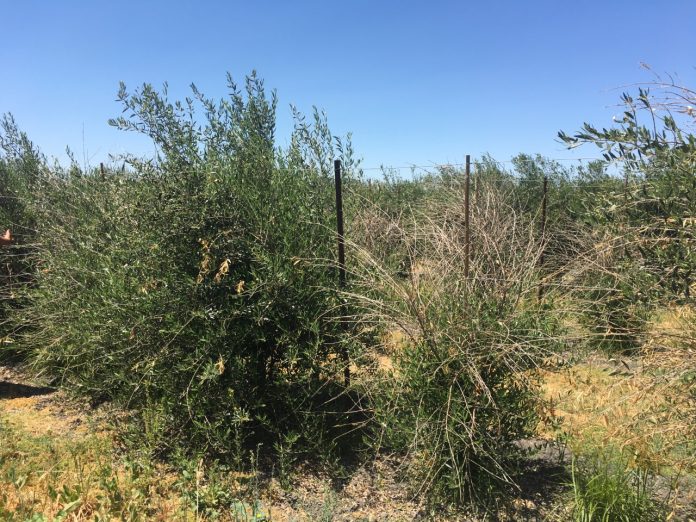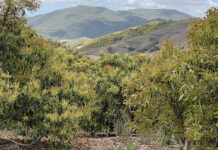
Super-high-density oil olive plantings have increased in acreage in several growing regions in California while table olive acreage continues to decline. In San Joaquin County, nearly 5,500 oil olive acres are now in production. In their Field Notes publication, UCCE Advisor Mohammad Nouri and UC Kearney Plant Pathologist Florent Trouillas described the challenges of diagnosing symptoms with different causes.
Symptoms of the fungal disease Verticillium wilt and freeze or frost damage can be similar, Nouri noted.
The soilborne fungus that causes Verticillium wilt has both non-defoliating and defoliating types. Symptoms usually begin in the spring and slowly worsen in the summer. The non-defoliating type can cause rapid dieback and wilting, especially in young trees as the pathogen invades the tree’s vascular system. The defoliating type causes early drop of asymptomatic green leaves from individual twigs and branches.
Look inside the affected branches to tell the difference. With Verticillium wilt, compared to freeze or frost damage, obstructed vessels become dark and inner vascular tissues show dark streaking. Advanced stages include shoot wilting, dieback and foliar necrosis, which are also associated with freeze damage.
Nouri said olive trees affected by cold temperatures during the growing season have frost damage. Freeze damage occurs in late fall or winter while trees are dormant. Initial damage includes tip dieback, lack of luster to the leaves and curling up of leaves as well as some necrotic or chlorotic lesions and leaf drop.
His observations are that a dry fall may make freeze damage worse. Cutting back on irrigation in September and avoiding nitrogen applications can help slow growth and may help trees harden off before a sudden freeze event. If a freeze is forecast, having a moist soil surface can help store more heat. Symptoms of freeze damage will appear when the weather warms. Sufficient moisture helps trees recover. Pruning should be delayed until warmer weather begins to stress the trees to see where recovery is possible as new shoots grow. Branches and limbs damaged by freeze will be easily identified and can be removed. The soil profile should be wet to the depth of rooting when spring growth begins to stimulate root activity.
Nouri said that trees severely affected by freeze damage will have less total growth, which will reduce the nitrogen requirement, but will stimulate vigorous re-growth similar to heavy pruning. Fertilizer decisions for the growing season following a freeze should be based on current soil reports and leaf analysis.






















